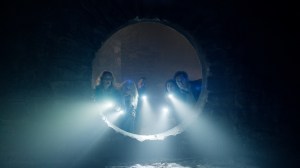
It was recently announced that DC Comics character John Constantine would be returning to the pages of his own story beginning with a one-shot, The Sandman Universe Presents Hellblazer #1, in October followed by another #1 issue to launch an ongoing series. While the character has featured in multiple ongoing solo and team series in recent memory, this news stood out for one notable change. The newest comic to showcase John Constantine would not fall under the primary DC Comics umbrella, a change from his three most recent series. This title will be considered part of the Sandman Universe imprint, which is currently part of the Vertigo Comics line, and will presumably be shifted to the newly announced mature readers imprint, Black Label, once Vertigo is officially shuttered. That marks an important change in the history of this character’s more than 30 years of history.
Videos by ComicBook.com
Reviewing the many stories of John Constantine reveals a fascinating narrative and meta-narrative. The former delves into the sort of character readers would never expect to see at a superhero comics publisher, even today, and how he became a popular and resonant figure within the medium. The latter reveals changes in publishing strategy and how popular intellectual property has been managed by DC Comics across so many years of history. Taken together, it’s clear to see why the return of John Constantine to Vertigo (and Black Label, most likely) is a sign that both the character and publisher are on the right course.
However, as with almost all good stories, it’s best to start at the beginning. That means returning to 1985 when John Constantine’s co-creators, Alan Moore, Stephen R. Bissette, Rick Veitch, and John Totleben, were collaborating in the pages of The Saga of the Swamp Thing.

His Disreputable Origins
Constantine was not originally conceived to be a leading man. He was created both to provide a supporting figure with some occult knowledge in Swamp Thing’s ongoing stories (now considered to be modern classics) and offer artists a chance to draw an homage to the musician Sting. His iconic look with a dark suit and trench coat slowly emerged after some more dapper initial outfits, but his personality was recognizable from a first appearance in The Saga of the Swamp Thing #37. Constantine was always untrustworthy, smarmy cynic working with powers and knowledge far greater than himself.
While Constantine’s past was invented and expanded throughout the following decades, much of his essential origin was known, if not revealed, from his early appearances. Constantine is depicted as being cynical and mercenary when he meets Swamp Thing due to his own failures. Throughout The Saga of the Swamp Thing he loses friends connected to his past life, specifically an incident in which he attempted to summon a demon to save a little girl, Astra, traumatized by abuse. The spell goes wrong resulting in the death or madness of multiple others and Astra being dragged to hell. It was the original sin that made Constantine the irredeemable bastard, a persona he eventually embraced and projected.
Constantine eventually left his supporting part to feature as the centerpiece of Hellblazer, a new Vertigo Comics series that would eventually run for 300 issues and feature a murderer’s row of great comics talents, including Garth Ennis, Warren Ellis, Steve Dillon, Jamie Delano, and David Lloyd. Throughout the series Constantine aged in real-time and was primarily depicted as the protagonist of his own universe, one that rarely crossed over with other recognizable properties. Each notable run emphasized different attributes, but the tone remained darkly realistic, treating Constantine as a grifter and addict. No matter how much the character might aspire to do good, he was continually shown to be incapable of overcoming his nature and past sins, creating a story far too dark for the mainstream of DC Comics, no matter the era.

A Walk on the Not-So-Wild Side
That didn’t stop editors and creators from becoming interested in the possibility of a crossover. Constantine might have stuck primarily to his own series for multiple decades, but he also managed to spawn outside interest, resulting in the 2005 film Constantine. The possibilities for expansion (and slow decline of Vertigo) may have been the reasons why it was decided that John Constantine would join the stories of Superman, Batman, and Wonder Woman in the 2011 relaunch of DC Comics titled the “New 52.”
Constantine initially appeared as part of the team featured in Justice League Dark, starring alongside the likes of Zatanna, Deadman, and former ally Swamp Thing. The attitude and appearance remained the same, but the shift in genre from horror to superhero fundamentally altered the tone of Constantine’s stories. He was made to look bad in comparison to the more heroic figures surrounding him, but these stories typically featured a “heart of gold” approach in which John’s actions could be justified by seemingly impossible choices and utilitarian thinking. He was no longer an anti-hero that readers would be wary of rooting for, and more of a hero with a dark past and willingness to go further than most; more Wolverine than Walter White. The superhero surroundings also drowned out much of the character’s aesthetic, colorful spectacles and absurdly complex plotting with multiple earths made his modus operandi appear more bland than darkly appealing.
These problems have been consistent throughout Constantine’s many stories at DC Comics. It was announced in 2013 that Hellblazer would end and be rebooted in the New 52 series Constantine. The series has been restarted twice more and Constantine has continued to feature in events, team titles, and crossovers, all with similarly dismaying effects. Everything that made The Saga of the Swamp Thing and Hellblazer renowned comics had been washed away to fit one character into a very different setting and genre.

An Appropriately Dim Future
The decision to seemingly remove Constantine from the mainstream of DC Comics and return him to the publisher’s mature imprints is a good sign both for this one creative property and about DC’s recent reorganization. There’s a recognition that almost a full decade of superhero Constantine stories simply have not worked, failing to create a new fandom or drive sales. Shifting Constantine back to Vertigo re-opens the door for the sort of stories that remain critical darlings and allowed a supporting Swamp Thing character to eventually transition to film and television.
More significantly, it provides some insight into how the restructuring of Black Label and DC Comics might work. These two lines have been described primarily as age classifications, with all of the current DC comics based in a superhero-oriented continuity under the DC Comics umbrella aimed at young adult readers. It’s not the place for the classic Constantine who abuses drugs, abuses his loved ones, and rests beyond redemption. Placing the character at Vertigo just as it prepares to wrap operations and allow Black Label to begin in earnest, shows the sorts of stories that might make Black Label a hit. They’re the same sorts of experimental and adult stories that made many series, like Sandman and Hellblazer, so successful that the Vertigo label had to be created for them. It shows that the spirit of that imprint may live on, even if the name is changed.








